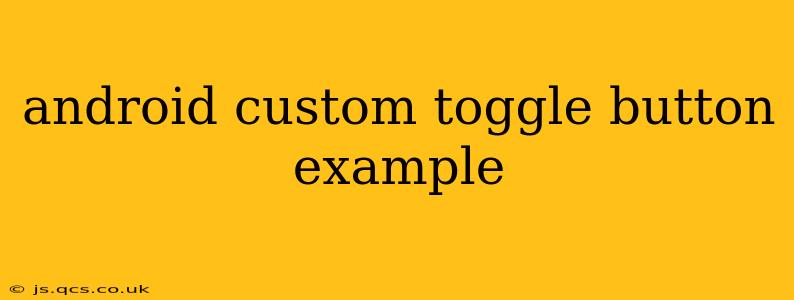Creating a custom toggle button in Android allows for a highly personalized user experience, going beyond the limitations of standard components. This guide dives deep into the process, providing you with the knowledge and code examples to design and implement your own unique toggle buttons. We'll cover various aspects, from basic implementation to advanced customization options.
What is a Custom Toggle Button?
A custom toggle button in Android is a user interface element that deviates from the default appearance and functionality of the standard ToggleButton or Switch widgets. This allows developers to tailor the button's look and behavior to perfectly match their app's design and functionality. This might involve changing the colors, shapes, animations, or even the entire visual representation.
Why Create a Custom Toggle Button?
There are several reasons why you might choose to create a custom toggle button instead of using the built-in options:
- Branding: Matching the toggle button's style to your app's branding is crucial for a cohesive user experience. Custom buttons allow for perfect alignment with your design language.
- Unique Functionality: Standard toggle buttons offer basic on/off functionality. Custom buttons can incorporate more complex actions or interactions.
- Improved User Experience: A well-designed custom toggle button can enhance the usability and appeal of your app.
- Enhanced Aesthetics: Go beyond the standard look and feel to create a truly unique and visually appealing toggle button.
Implementing a Basic Custom Toggle Button
The simplest way to create a custom toggle button is by extending the View class and overriding the drawing methods. This gives you complete control over the visual representation. Here’s a basic example demonstrating the principle:
public class CustomToggleButton extends View {
private boolean isChecked = false;
private Paint paint;
public CustomToggleButton(Context context) {
super(context);
init();
}
private void init() {
paint = new Paint();
paint.setColor(Color.BLUE); // Set your desired color
}
@Override
protected void onDraw(Canvas canvas) {
super.onDraw(canvas);
if (isChecked) {
// Draw the "on" state representation
canvas.drawRect(0, 0, getWidth(), getHeight(), paint);
} else {
// Draw the "off" state representation
//Example: Draw nothing for off state.
}
}
public void setChecked(boolean checked) {
isChecked = checked;
invalidate(); // Redraw the view
}
//Add onClick listener here and call setChecked appropriately
//...
}
This code provides a basic rectangular toggle button that changes color when toggled. You would need to add an OnClickListener and handle the click event to change the isChecked state and redraw the view. Remember to include this custom view in your XML layout.
How to Add Animations to Your Custom Toggle Button
Adding animations elevates the user experience. You can achieve this using ObjectAnimator or ValueAnimator to control properties such as translation, scale, or color changes. For example, you can animate the color change on toggle:
ObjectAnimator colorAnimator = ObjectAnimator.ofArgb(paint, "color", Color.BLUE, Color.RED);
colorAnimator.setDuration(300); // Animation duration in milliseconds
colorAnimator.start();
This code snippet animates the color of the paint object from blue to red over 300 milliseconds. You would incorporate this within your setChecked method.
Handling Click Events in Your Custom Toggle Button
You need to add an OnClickListener to your custom toggle button to detect clicks and change the isChecked state:
this.setOnClickListener(new OnClickListener() {
@Override
public void onClick(View v) {
setChecked(!isChecked);
}
});
This ensures the button toggles its state when clicked.
How to Customize the Appearance of Your Toggle Button
Customization is key! You can modify the above examples to control virtually every aspect of the toggle button's appearance:
- Shapes: Use
canvas.drawRoundRect,canvas.drawOval, or other canvas drawing methods to create different shapes. - Colors: Experiment with different colors using the
Paintobject. - Images: Draw images using
canvas.drawBitmap. - Text: Add text labels using
canvas.drawText.
Remember to handle different screen densities and resolutions appropriately to ensure your custom toggle button scales well across various devices.
Using a Drawable for Simpler Customizations
A simpler approach for less complex customizations is utilizing a StateListDrawable in your XML layout. This allows you to define different states (pressed, focused, checked, unchecked) with different drawables, reducing the need for extensive custom drawing code.
Advanced Techniques: Using Libraries and External Resources
For even more advanced customization, consider using libraries like Glide (for image loading) or Lottie (for animations). These tools can help you efficiently manage complex visual elements and animations within your custom toggle button.
This comprehensive guide provides a solid foundation for creating custom toggle buttons in Android. By combining the basic principles with your creativity and the advanced techniques mentioned, you can design truly unique and functional UI elements that enhance your app's overall design and user experience. Remember to always test thoroughly on different devices and Android versions for optimal compatibility.
